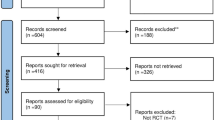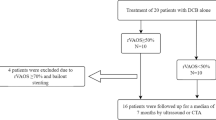Abstract
This meta-analysis aims to compare percutaneous transluminal angioplasty (PTA) to medical treatment (MT) for symptomatic vertebral artery stenosis (SVAS) treatment. We searched PubMed, Springer, Google Scholar, Clinical Trials, Cochrane Central, Chinese National Knowledge Infrastructure, and China Biological Medicine databases. All relevant comparative trials were included. All summary estimates were calculated by random-effect models. Ten comparative trials involving 672 patients were identified. Within 30-day follow-up, there was no significant difference between PTA plus MT and MT alone in vascular death, any stroke, posterior circulation TIA, posterior circulation infarction, and ischemic stroke (all P > 0.05). With a follow-up of more than 1 year, no significant difference was found between PTA plus MT and MT alone in all-cause death (3 vs. 7 %, P = 0.24), vascular death (4 vs. 7 %, P = 0.34), posterior circulation stroke (5 vs. 8 %, P = 0.48), posterior circulation ischemic events (8 vs. 25 %, P = 0.23), posterior circulation TIA (10 vs. 38 %, P = 0.11), posterior circulation infarction (6 vs. 12 %, P = 0.51), vertebral artery occlusion (6 vs. 12 %, P = 0.58), and in secondary long-term events, including any stroke, anterior circulation stroke, hemorrhagic stroke, and myocardial infarction (all P > 0.05), although PTA plus MT could largely reduce the vertebral artery stenosis rate [MD 63.05 %, 95 % CI (32.77–93.34 %), P < 0.01]. Hence, PTA plus MT may be not superior to MT alone for SVAS treatment. Larger randomized trials are needed to verify the optimum therapy for SVAS.




Similar content being viewed by others
References
Gross BA, Albuquerque FC (2015) Stenting versus aggressive medical management for symptomatic vertebral artery stenosis. World Neurosurg 84:613–615
Compter A, van der Hoeven EJ, van der Worp HB et al (2015) Vertebral artery stenosis in the basilar artery international cooperation study (BASICS): prevalence and outcome. J Neurol 262:410–417
Kerber KA, Rasmussen PA, Masaryk TJ, Baloh RW (2005) Recurrent vertigo attacks cured by stenting a basilar artery stenosis. Neurology 65:962
Arboix A, Arbe G, Garcia-Eroles L, Oliveres M, Parra O, Massons J (2011) Infarctions in the vascular territory of the posterior cerebral artery: clinical features in 232 patients. BMC Res Notes 4:329
Gulli G, Marquardt L, Rothwell PM, Markus HS (2013) Stroke risk after posterior circulation stroke/transient ischemic attack and its relationship to site of vertebrobasilar stenosis: pooled data analysis from prospective studies. Stroke 44:598–604
Gulli G, Khan S, Markus HS (2009) Vertebrobasilar stenosis predicts high early recurrent stroke risk in posterior circulation stroke and TIA. Stroke 40:2732–2737
Rothwell PM, Giles MF, Chandratheva A et al (2007) Effect of urgent treatment of transient ischaemic attack and minor stroke on early recurrent stroke (EXPRESS study): a prospective population-based sequential comparison. Lancet 370:1432–1442
Stayman AN, Nogueira RG, Gupta R (2011) A systematic review of stenting and angioplasty of symptomatic extracranial vertebral artery stenosis. Stroke 42:2212–2216
Storey GS, Marks MP, Dake M, Norbash AM, Steinberg GK (1996) Vertebral artery stenting following percutaneous transluminal angioplasty. Technical note. J Neurosurg 84:883–887
Parkhutik V, Lago A, Tembl JI, Aparici F, Vazquez V, Mainar E (2010) Angioplasty and stenting of symptomatic and asymptomatic vertebral artery stenosis: to treat or not to treat. Eur J Neurol 17:267–272
Mohammadian R, Sharifipour E, Mansourizadeh R et al (2013) Angioplasty and stenting of symptomatic vertebral artery stenosis. Clinical and angiographic follow-up of 206 cases from Northwest Iran. Neuroradiol J 26:454–463
Vajda Z, Miloslavski E, Guthe T et al (2009) Treatment of stenoses of vertebral artery origin using short drug-eluting coronary stents: improved follow-up results. Am J Neuroradiol 30:1653–1656
Jiang WJ, Xu XT, Du B et al (2007) Long-term outcome of elective stenting for symptomatic intracranial vertebrobasilar stenosis. Neurology 68:856–858
Coward LJ, McCabe DJ, Ederle J, Featherstone RL, Clifton A, Brown MM (2007) Long-term outcome after angioplasty and stenting for symptomatic vertebral artery stenosis compared with medical treatment in the carotid and vertebral artery transluminal angioplasty study (CAVATAS): a randomized trial. Stroke 38:1526–1530
Compter A, van der Worp HB, Schonewille WJ et al (2015) Stenting versus medical treatment in patients with symptomatic vertebral artery stenosis: a randomised open-label phase 2 trial. Lancet Neurol 14:606–614
Derdeyn CP, Chimowitz MI, Lynn MJ et al (2014) Aggressive medical treatment with or without stenting in high-risk patients with intracranial artery stenosis (SAMMPRIS): the final results of a randomised trial. Lancet 383:333–341
Karameshev A, Schroth G, Mordasini P et al (2010) Long-term outcome of symptomatic severe ostial vertebral artery stenosis (OVAS). Neuroradiology 52:371–379
Li JJ, Cai YL, Liu L, Du J, Wu Z, Kong XK (2015) Comparative study between stenting and medication for vertebral artery origin stenosis. Chin J Cerebrovasc Dis 12(1):1–6
Liu C (2012) Comparative study between stenting and medication for symptomatic vertebral artery stenosis. Chin J Pract Nerv Dis 15(1):74–75
Tang Z, Ouyang S, Yang GD (2015) To investigate the efficacy and safety of stenting and drug therapy alone in treating patients with vertebral artery stenosis. Proc Clin Med 24(12):896–899
Zhang GY (2015) Comparative study for clinical effect on severe vertebral artery origin stenosis between drug therapy and stent-assisted angioplasty. PJCCPVD 23(8):50–53
Zhao HF, Wang D, Zhang LH (2014) Short-term outcomes in patients with symptomatic vertebral artery stenosis after stenting. Chin J Geriatr Heart Brain Vessel Dis 16(5):510–513
Zhu HC, Zhang YH, Guan S, Shui SF (2010) Comparative study for clinical effect on 69 patients with vertebral artery stenosis between drug therapy and stenting. J Apopl Nerv Dis 27(3):270–271
Higgins JP, Green S (2011) Cochrane handbook for systematic reviews of interventions, version 5.1.0, the Cochrane Collaboration. http://handbook.cochrane.org/. Accessed 6 July 2016
Slim K, Nini E, Forestier D, Kwiatkowski F, Panis Y, Chipponi J (2003) Methodological index for non-randomized studies (minors): development and validation of a new instrument. ANZ J Surg 73:712–716
DerSimonian R, Laird N (1986) Meta-analysis in clinical trials. Control Clin Trials 7:177–188
Higgins JP, Thompson SG (2002) Quantifying heterogeneity in a meta-analysis. Stat Med 21:1539–1558
Begg CB, Mazumdar M (1994) Operating characteristics of a rank correlation test for publication bias. Biometrics 50:1088–1101
Akins PT, Kerber CW, Pakbaz RS (2008) Stenting of vertebral artery origin atherosclerosis in high-risk patients: bare or coated? A single-center consecutive case series. J Invasive Cardiol 20:14–20
Coward LJ, Featherstone RL, Brown MM (2005) Percutaneous transluminal angioplasty and stenting for vertebral artery stenosis. Cochrane Database Syst Rev. doi:10.1002/14651858.CD000516.pub2
Antoniou GA, Murray D, Georgiadis GS et al (2012) Percutaneous transluminal angioplasty and stenting in patients with proximal vertebral artery stenosis. J Vasc Surg 55:1167–1177
Brandt T, Baloh RW (2005) Rotational vertebral artery occlusion: a clinical entity or various syndromes? Neurology 65:1156–1157
Bain M, Hussain MS, Gonugunta V, Moskowitz S, Hui FK, Gupta R (2010) Indirect reperfusion in the setting of symptomatic carotid occlusion by treatment of bilateral vertebral artery origin stenoses. J Stroke Cerebrovasc Dis 19:241–246
Persoon S, Klijn CJ, Algra A, Kappelle LJ (2009) Bilateral carotid artery occlusion with transient or moderately disabling ischaemic stroke: clinical features and long-term outcome. J Neurol 256:1728–1735
Tsivgoulis G, Krogias C, Georgiadis GS et al (2014) Safety of early endarterectomy in patients with symptomatic carotid artery stenosis: an international multicenter study. Eur J Neurol 21(1251–1257):e75–e76
Acknowledgments
This study was funded by the National Natural Science Foundation of China (81371273).
Author information
Authors and Affiliations
Corresponding author
Ethics declarations
Conflicts of interest
The authors declare that they have no conflict of interest.
Ethical standard
The manuscript does not contain clinical studies or patient data.
Electronic supplementary material
Below is the link to the electronic supplementary material.
415_2016_8267_MOESM2_ESM.eps
Supplementary Figure 2S: Forest plots of secondary long-term outcomes of PTA plus MT compared with MT alone for SVAS treatment (EPS 1157 kb)
415_2016_8267_MOESM3_ESM.docx
Supplementary Table 1S: Sensitivity analysis by excluding six trials with less than 3-year follow-up and Begg’s test for publication bias (DOCX 20 kb)
Rights and permissions
About this article
Cite this article
Feng, H., Xie, Y., Mei, B. et al. Endovascular vs. medical therapy in symptomatic vertebral artery stenosis: a meta-analysis. J Neurol 264, 829–838 (2017). https://doi.org/10.1007/s00415-016-8267-0
Received:
Revised:
Accepted:
Published:
Issue Date:
DOI: https://doi.org/10.1007/s00415-016-8267-0




